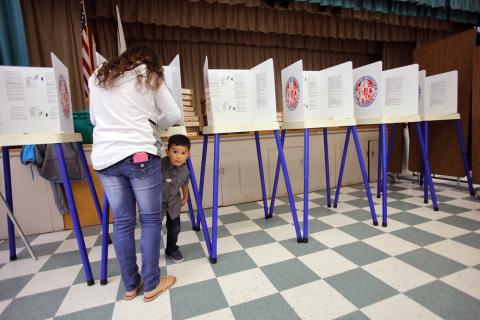The 2018 primary season will go down in history.
A record number of women secured party nominations, including the headline-making upsets by Alexandria Ocasio-Cortez and Ayanna Pressley. Retiring incumbents drew large numbers of diverse candidates competing for the open seat. Voter turnout peaked in several states and districts with competitive primaries.Topping the highlight reel was Maine, which became the first state in the country to use ranked choice voting in its June primary, with plans to carry the more democratic voting method through to choose its federal representatives in November.But not all of the standout moments from the 2018 primaries can be characterized as successes.The crowded fields filled by many viable contenders led to shockingly low plurality wins in many key races.Recent news coverage concentrated on the 10-way Democratic primary for Massachusetts’ 3rd Congressional District, results of which were finalized in a recount that ended two weeks later. While the narrow margin that separated winner Lori Trahan from runner-up Dan Koh - ultimately 143 votes, according to the recount - drew no shortage of attention, the even more disturbing number to come out of the primary was the 22 percent of votes that gave Trahan the win.As The Boston Globe noted in an editorial on the outcome, that meant nearly 80 percent of voters picked someone else.The same can be said for the Republican primary in Pennsylvania’s newly created 13th Congressional District. Retired physician John Joyce emerged the victor from the field of eight candidates with 22 percent of vote.No matter what side of the political aisle you fall on, the flagrant violation for America’s majority rule principle is cause for concern, especially when considering that both these primary winners are favored to take the general election, too.And that’s just the tip of the un-democratic iceberg.A dozen congressional primaries were won with the support of less than 30 percent of voters, while another 37 primary victors secured their party nomination with less than 40 percent of the votes, according to FairVote data on plurality voting primaries for House, Senate, governor, lieutenant governor and attorney general seats. (Note that states that use alternative systems like a “top two” primary or a primary runoff were not included in our data).From Alaska to Oklahoma, New Hampshire to Florida, a whopping 117 primary races for federal and state positions resulted in non-majoritarian outcomes.Ranked choice voting offers a solution that ensures election winners are chosen with the broadest possible percent of voters support. Consider how RCV worked in Maine’s seven-way Democratic gubernatorial primary.After none of the candidates secured a majority of first choice votes, the last place candidate was eliminated and those voters’ second choices were redistributed among the remaining candidates. By round four, Attorney General Janet Mills had crossed the 50 percent threshold, securing the nomination. Under plurality voting, Mills would still have won, but with just 33 percent of the votes.In races with closer margins between winner and runner-up - like the .04 percent that separated Kris Kobach and Jeff Koyler in Kansas’ Republican gubernatorial primary, an RCV ballot might have changed the outcome.But the point is not which candidate wins, or even which political party. Because when winners are chosen with less than 50 percent of the vote, everyone suffers.Candidates can’t claim they truly have the broadest support of voters. Runners-up will always wonder whether their losses were simply because of low plurality outcomes. And voters remain poorly represented by an anti-democratic system.Let’s make 2020 another year for the history books, but this time, by the record number of elections decided using ranked choice voting.Editor's Note: This article, written by Nancy Lavin, originally published on FairVote's blog, and has been modified slightly for publication on IVN.
Photo Credit: Joseph Sohm / shutterstock.com
